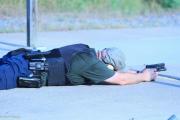A setback bullet is an interesting idea. That would require less odd stuff to have happened in the reloading process. However, the recoil impulse felt heavier than a typical 134k power factor load. My gut is that it was a very heavy charge.
How many reloading for that case? I have absolutely no clue. It's range pickup brass that's been used an unknown number of times. I usually have a stock of about 15000 cases that I cycle through, and brass at matches isn't picked up. So usually my brass doesn't get used a ton of times.
I've had lots of split cases, and they have never caused a problem. I just discard them. Split cases are easy to identify because the case mouth is typically smaller than the bullet diameter, so the bullet feed step fails.




 Reply With Quote
Reply With Quote



